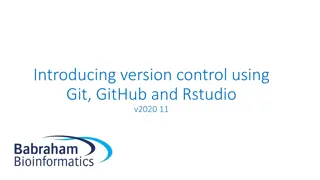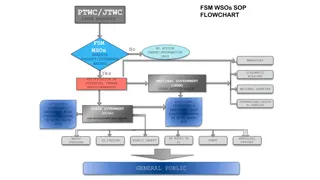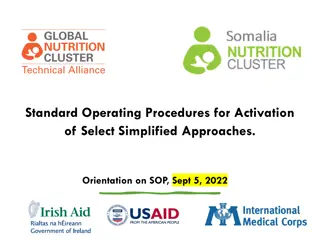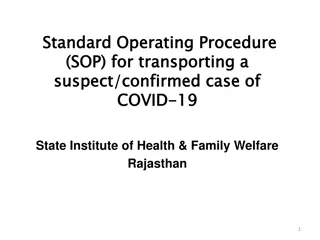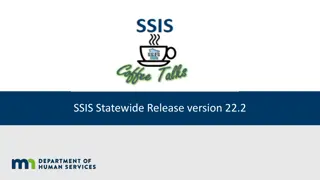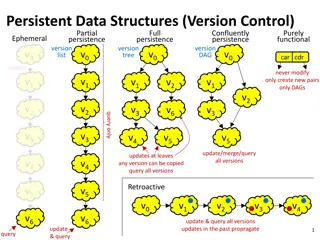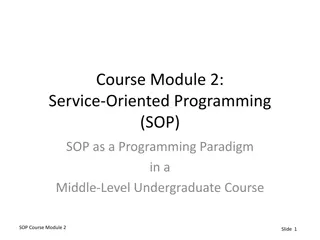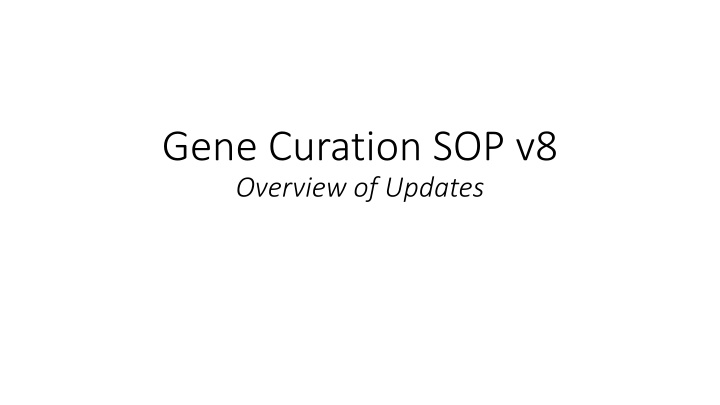
Genetic Evidence Scoring System Revamp and Variant Evaluation Guidelines
Explore the latest updates in the Gene Curation SOP v8, focusing on revamping the genetic evidence scoring system and providing guidelines for evaluating variant evidence at the case level. Understand the importance of downgrading missense variants without functional data clarity and the nuances in scoring de novo variants in different inheritance categories. Always consult your GCEP for final variant scoring decisions.
Download Presentation

Please find below an Image/Link to download the presentation.
The content on the website is provided AS IS for your information and personal use only. It may not be sold, licensed, or shared on other websites without obtaining consent from the author. If you encounter any issues during the download, it is possible that the publisher has removed the file from their server.
You are allowed to download the files provided on this website for personal or commercial use, subject to the condition that they are used lawfully. All files are the property of their respective owners.
The content on the website is provided AS IS for your information and personal use only. It may not be sold, licensed, or shared on other websites without obtaining consent from the author.
E N D
Presentation Transcript
Gene Curation SOP v8 Overview of Updates
Main Update: Revamp of Genetic Evidence Scoring System Issues: Need to downgrade missense variants without functional data unclear No distinction between types of de novo variants Distinct values for LOF and de novo variants in AD/X inheritance but not AR Category maximums penalizing non-LOF disease mechanisms SOP v7
Main Update: Revamp of Genetic Evidence Scoring System New! Baseline points assigned per variant type Add points to baseline for common upgrades No category maximums SOP v8
Always check with your GCEP to determine final variant scoring. Let this framework serve as a GUIDE.
Case-Level Variant Evidence Baseline number of points assigned per variant type Predicted/proven null = 1.5 points Other variant type (e.g., missense) = 0.1 points Add points to the baseline score for common upgrades as described in the table Functional data De novo status Other upgrades/downgrades may be appropriate at the discretion of your GCEP
Case-Level Variant Evidence For AR diseases: assess each variant independently, then sum for final score Round up to the nearest 0.5 EXCEPTION: For 2 missense variants w/o functional data, round to 0.25 No single proband may score more than 3 points
Caveats Default scores assume the variant type is consistent with the expected disease mechanism. If this is not the case, downgrade or do not score unless there is compelling rationale for partial scoring. Document this rationale in the GCI. For example, if the disease mechanism is known to be gain of function, consider not scoring null variants and upgrading gain of function missense variants. Variants may be up- or downgraded beyond the values suggested here (but within the scoring range) based on the strength of evidence. For example, a missense variant may score at the top of its range if robust functional assays demonstrate that the missense is acting in a manner consistent with the expected disease mechanism.
Caveats Variants may be up- or downgraded for other reasons beyond those listed in this chart at the discretion of the GCEP. Always document the rationale for up- or downgrading variants in the GCI. For example, one may opt to upgrade missense variants if they are within a known functional domain, if they appear to be clustering in the same area of the gene, etc. Consider upgrading based on consistency and/or specificity of the phenotype, the likelihood that a putative null variant actually leads to loss of function, etc. When assigning points for de novo status, consider further upgrades if statistical evidence shows that de novo variation in a particular gene is rare. Use caution (and consider not upgrading or not scoring) if a gene is known to have a high rate of de novo variation (e.g. TTN).
AD/XL Inheritance Example Scenarios 1 missense variant with no functional data = baseline 0.1 points Add functional data (0.1 + 0.4) = 0.5 points Add de novo status (0.1 + 0.4) = 0.5 points Add both (0.1 + 0.4 + 0.4) = 0.9 round to the nearest 0.5 = 1 point 1 LOF variant = baseline 1.5 points Add functional data (1.5 + 0.5) = 2 points Add de novo status (1.5 + 0.5) = 2 points Add both (1.5 + 0.5 +0.5) = 2.5 points
AD/XL Inheritance Example Scenarios 1 missense variant with no functional data = baseline 0.1 points Add functional data (0.1 + 0.4) = 0.5 points Add de novo status (0.1 + 0.4) = 0.5 points Add both (0.1 + 0.4 + 0.4) = 0.9 round to the nearest 0.5 = 1 point 1 LOF variant = baseline 1.5 points Add functional data (1.5 + 0.5) = 2 points Add de novo status (1.5 + 0.5) = 2 points Add both (1.5 + 0.5 +0.5) = 2.5 points
AR Inheritance Example Scenarios Score for Variant 1 + Score for Variant 2 = Final Score Round to nearest 0.5 EXCEPT for 2 missense w/o functional data (round to 0.25) Example: Variant 1 is a missense variant w/o functional data. Variant 2 is a de novo LOF variant Variant 1 = 0.1 points Variant 2 = 1.5 + 0.5 = 2 points Total score: 0.1 + 2 = 2.1 round down to 2 points
AR Inheritance Example Scenarios Score for Variant 1 + Score for Variant 2 = Final Score Round to nearest 0.5 EXCEPT for 2 missense w/o functional data (round to 0.25) Example: Variant 1 is a missense variant with functional data. Variant 2 is a de novo missense variant Variant 1 = 0.1 + 0.4 = 0.5 points Variant 2 = 0.1 + 0.4 = 0.5 points Total score: 0.5 + 0.5 = 1 point
AR Inheritance Example Scenarios Score for Variant 1 + Score for Variant 2 = Final Score No single proband can score more than 3 points Example: Variant 1 is a LOF variant with functional data. Variant 2 is a de novo LOF variant Variant 1 = 1.5 + 0.5 = 2 points Variant 2 = 1.5 + 0.5 = 2 points Total score: 2 + 2 = 4 points CAP AT 3 POINTS
Entering this information in the GCI The GCI will not immediately reflect this change in scoring organization. At this time, you will still need to select from the old variant scoring categories (e.g., LOF, de novo, etc.) The defaults programmed into the GCI may not reflect the recommended scoring per SOP v8 you may need to adjust. In addition to any notes you normally would make, you can include Adjusted default scoring per recommendations in SOP v8 in the Reason for changed score field. The GCI team is working on the necessary updates to enable this scoring.
Other changes Reminder to groups to enter gene/disease/MOI and any precuration information into the GeneTracker Current work-around for including large, intragenic CNVs in curation Evidence summaries are now REQUIRED
Reminder: Enter all gene lists, precuration information, etc. into Gene Tracker
Evidence summaries are now REQUIRED Will discuss more on a future Biocurator call








